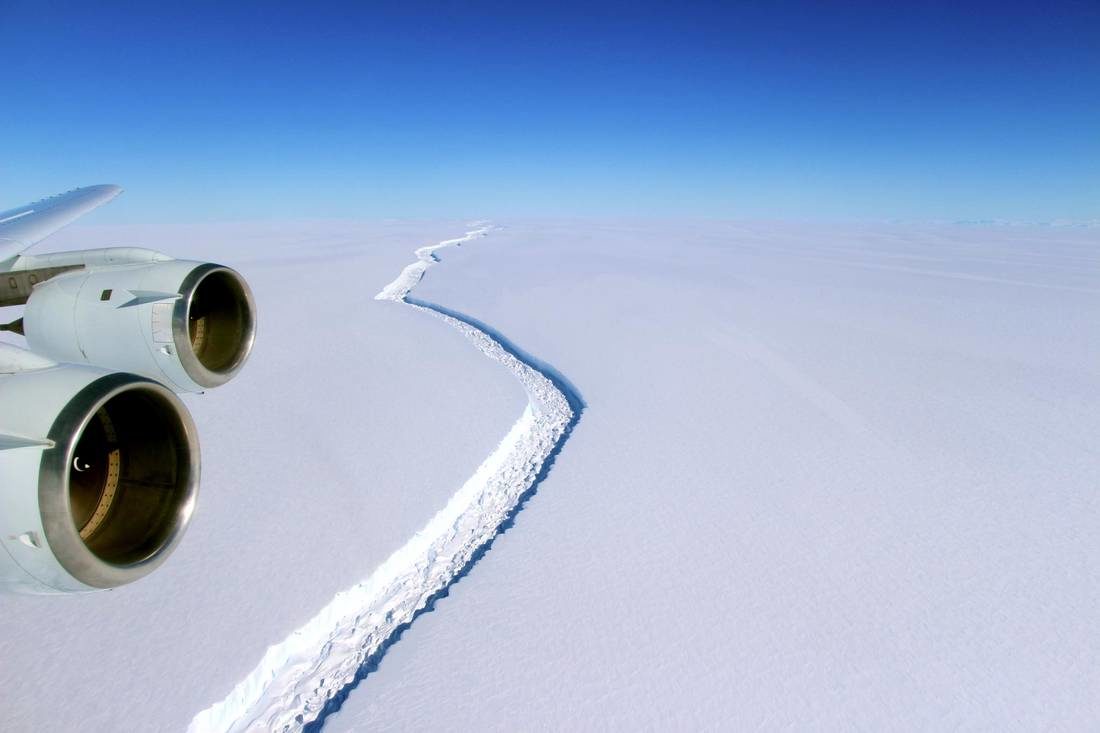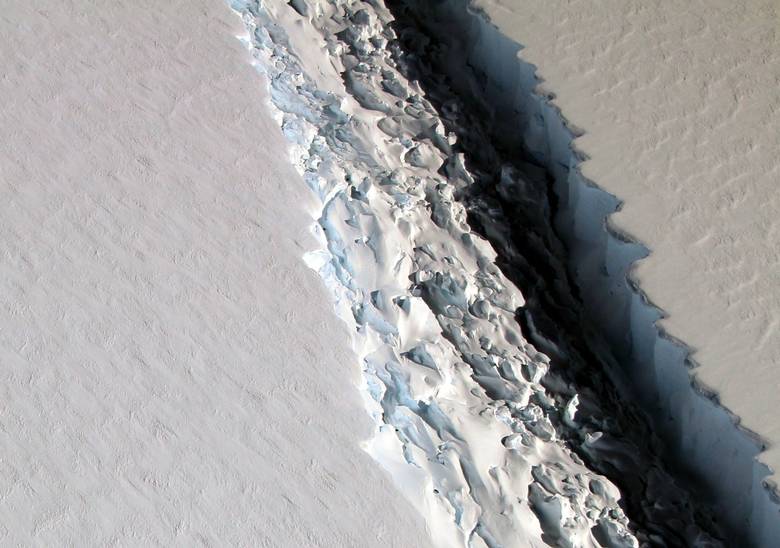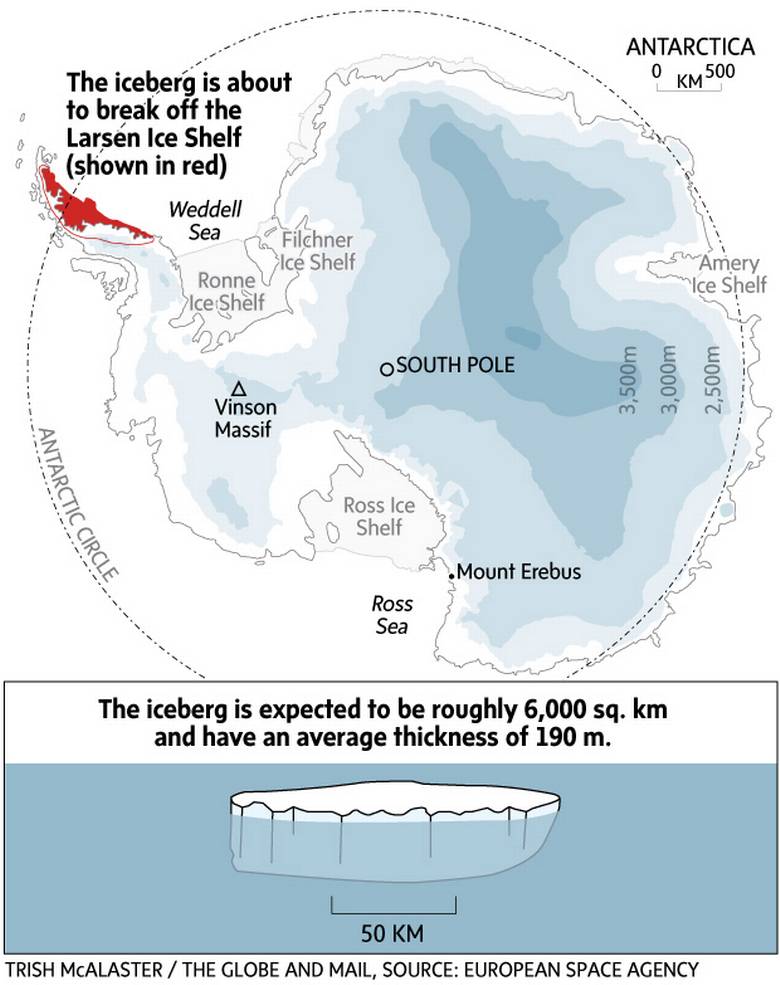An iceberg larger than Prince Edward Island will break off of Antarctica’s fourth-largest ice shelf in the coming days. Scientists are divided about the cause behind this grand event. Some say it’s a natural occurrence typical of most ice shelves, while others believe it could be closely linked to climate change. Because the imminent iceberg is already floating in water, it won’t directly impact sea levels immediately, but some scientists say there may be long-term implications. The iceberg may also pose a risk to ships in the surrounding waters, as it floats and breaks off into little pieces, eventually reaching as far north as the Falkland Islands.

On Nov. 10, 2016, scientists on NASA’s IceBridge mission photographed an oblique view of a massive rift in Antarctica’s Larsen C ice shelf. The crack completely cuts through the shelf, but does not yet span its entire width. The rift has been around since at least the 1950s, when it was captured on satellite images, but since December of last year, it has grown the length of about five football fields each day. JOHN SONNTAG/NASA PHOTO
The history
Ice shelves, which float on water, are an important barrier that prevent land-based ice sheets and glaciers from melting into the ocean and adding to rising sea levels. Scientists say that rising sea levels, which result in more flooding and could impact drinking water and wildlife habitats, are caused primarily by melting ice sheets and glaciers and the expansion of sea water as it warms.
The Antarctic ice sheet is the largest single mass of ice on Earth. With annual average temperatures ranging from -5 C to -60, most of the snow that falls in the region piles up throughout the year. Over a period of millions of years, the growing pile of snowfall has resulted in an ice sheet that forms ice shelves.
The European Space Agency has been monitoring how ice is changing to improve understanding of the effects to the region and beyond. It has been tracking a rift on Antarctica’s Larsen C ice shelf since 2011 using satellites. The ice shelf has an area of about 50,000 square kilometres, which is roughly the size of Nova Scotia. Once the crack completes its path, it will produce one of the largest icebergs ever recorded at a size of 6,600 sq. km – larger than Prince Edward Island.
The rift has been around since at least the 1950s, when it was captured on satellite images gathered during the Cold War period. In 2011, the crack was visible but not advancing rapidly, but since December of last year, it has grown the length of about five football fields each day. The rift is now around 200 kilometres long, leaving just five kilometres between the end of the fissure and the ocean, according to the ESA.
“This is a normal event day in the life of an ice shelf, but what is capturing people’s attention is just the size of this thing,” ESA scientist Dr. Mark Drinkwater said. He added Larsen C is still in stable condition, unlike its sister shelves, Larsen A and B, which both disintegrated due to a combination of factors.

The crack in the ice is now around 200 km long, leaving just five km between the end of the fissure and the ocean. JOHN SONNTAG/NASA PHOTO
The effects
The enormous iceberg is poised to float off in the Weddell Sea, south of the tip of South America. The iceberg, scientists say, will pose a threat to commercial and cruise ships in the area.
If the iceberg manages to exit the Southern Ocean close to Antarctica and into the South Atlantic, it will reach warmer water and this will fragment the iceberg into smaller pieces, making it more difficult for scientists to track.
“It might break up at some point into a whole bunch of little icebergs,” said Dr. Shawn Marshall, a geography professor and Canada Research Chair in Climate Change at the University of Calgary. “This will almost pose a greater risk because they will be fragmented, which will be a bit harder to track; this is going to be something in the navigation charts for years and years because it needs to be monitored very closely.”
The expected break-off, on its own, will not affect global sea level because the ice that has detached was already afloat in the ocean. But some scientists fear that it could quicken the destabilization of the larger Larsen C ice shelf.
Floating in water, ice shelves provide structural support to the glaciers that rest on land. When they collapse, the glaciers behind it can accelerate the flow of ice into the ocean. If the ice shelf breaks at the crack, Larsen C will be at its smallest size ever recorded.
“You need an ice shelf to plug the glacier flow and provide some resistance to the glacier so that it doesn’t flow freely into the ocean. The ice shelf provides a safety belt,” Dr. Drinkwater said. “What we do need to do is continue to monitor Larsen C over time to watch if it evolves into something more unstable because, as of now, it’s still in a stable condition.
“What we’ve seen when Larsen B and A were removed, in the response of the glaciers, is that ice flows faster in those glaciers because you remove the resistance that the ice shelves offer,” he added.
The debate
Scientists are divided about the impact of climate change on this particular break in Antarctica’s ice shelf. Some say it’s the result of a natural phenomenon caused by increased pressure and stress on the Larsen C shelf, a process any healthy ice shelf endures. Others say it’s a combination of factors, one of which includes global warming.
Dr. Drinkwater said there’s little proof that this break in particular is caused by climate change, adding that ice shelves break off commonly. He has seen ice shelves in Antarctica impacted by global warming, such as Larsen A and B ice shelves, but he can’t say the same definitively for this one.
“Ice shelves are suffering because of the effects of climate warming and that manifests in a number of ways, either because of the effects of the ice melting on the surface or because the ocean is bringing warm water beneath the ice shelves,” he said, adding that scientists have been anticipating this happening for years and “the main message is that this a typical event for the Larsen C.”
Dr. Marshall said although it’s hard to tell because ice breaking off shelves is a natural event, he’s adamant that climate change is playing a role in this occurrence.
“This event is pretty huge and as far as most people know, this ice shelf has been there for thousands of years, so I suspect it is happening as a result of warmer air conditions,” he said. “I don’t think it’s hard to draw a link that the breakup of this ice shelf is tied to global warming.”
Recent studies have suggested that the ice of Larsen C has been thinning and its surface has been getting lower in the water, which suggests that it might be melting from below.

Larsen C in numbers
Larsen C is the fourth-largest ice shelf in Antarctica, with an area of about 50,000 square kilometres, which is roughly the size of Nova Scotia.
The deep crack along the Larsen C ice shelf is continuing to cut across the ice. The crack in the ice is now around 200 km long, leaving just five km between the end of the fissure and the ocean.
Scientists are predicting that the eventual iceberg may be about 6,600 sq. km– larger than Prince Edward Island – making it one of the biggest icebergs ever.
Scientists predict that 30 metres of the floating ice island will be above sea level.
MIRIAM KATAWAZI
THE GLOBE AND MAIL
LAST UPDATED: WEDNESDAY, JUL. 05, 2017 10:09PM EDT
